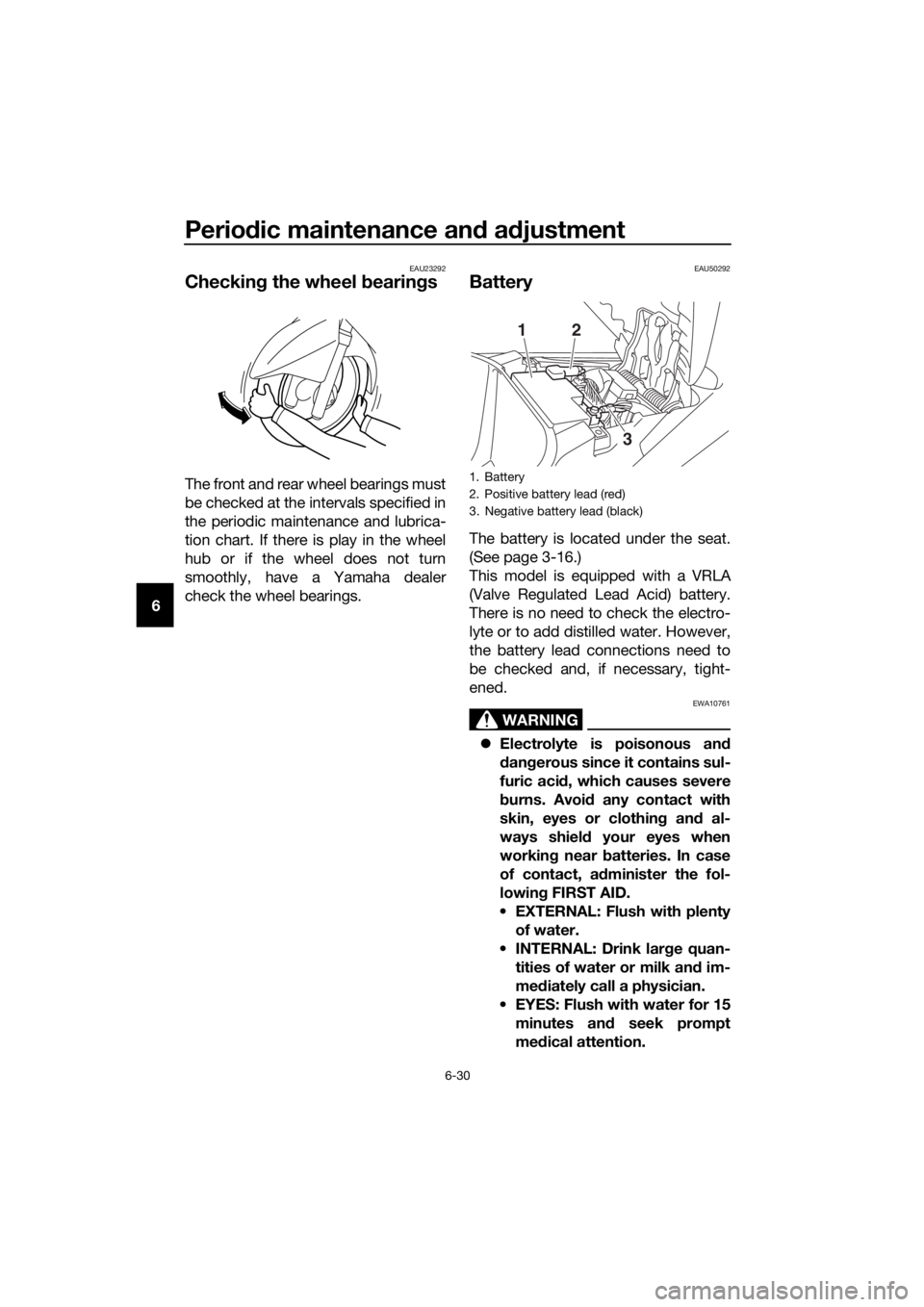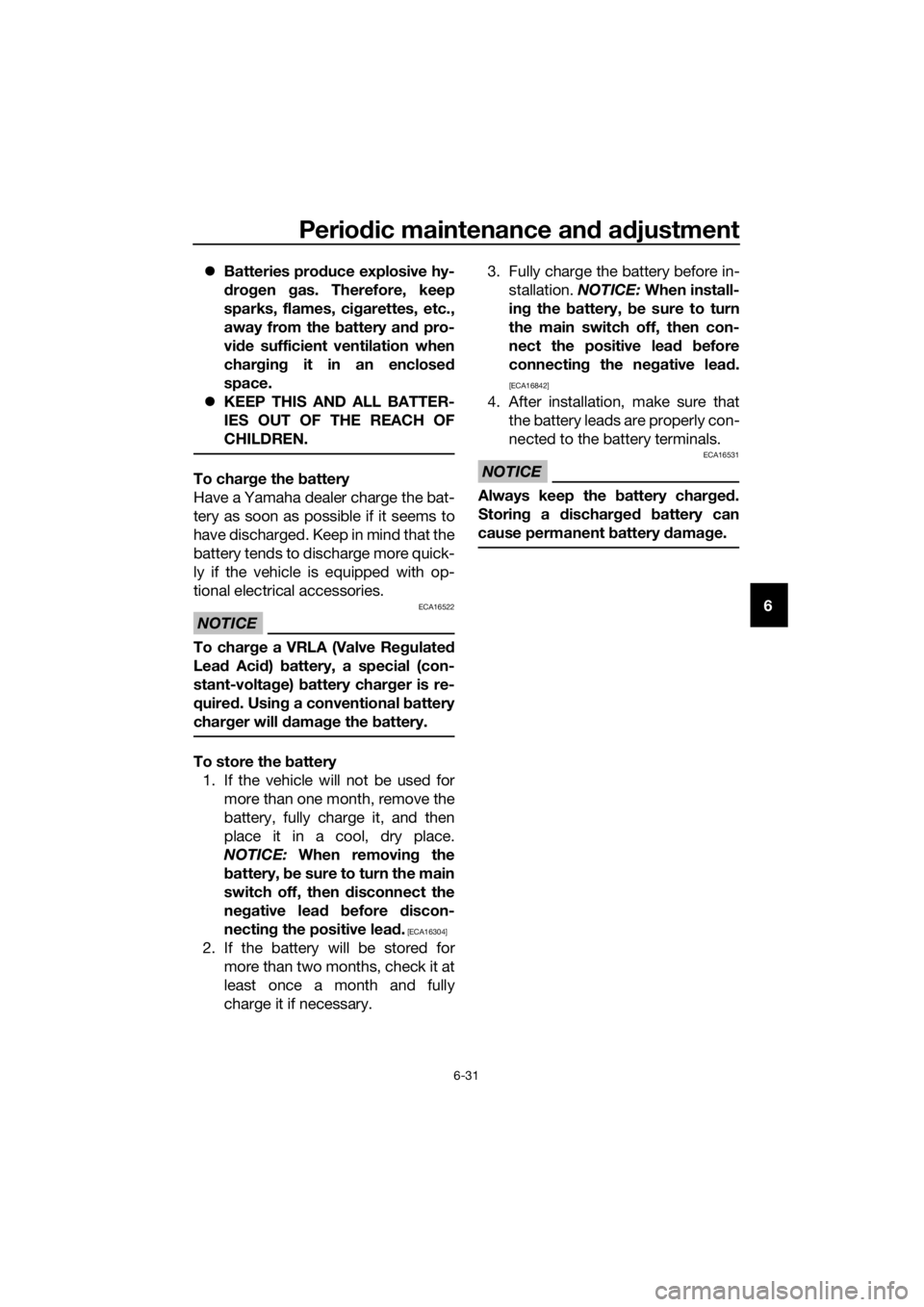2019 YAMAHA NMAX 125 battery
[x] Cancel search: batteryPage 5 of 94

Table of contents
Safety information ............................1-1
Further safe-riding points ................1-5
Description ........................................2-1
Left view ..........................................2-1
Right view........................................2-2
Controls and instruments ................2-3
Instrument an d control functions ....3-1
Main switch/steering lock ...............3-1
Keyhole shutter ...............................3-2
Indicator lights and warning lights ............................................3-3
Multi-function meter unit .................3-4
Handlebar switches.........................3-9
Front brake lever ...........................3-10
Rear brake lever ............................3-11
ABS ...............................................3-11
Fuel tank cap.................................3-12
Fuel................................................3-13
Fuel tank overflow hose ................3-15
Catalytic converter ........................3-15
Seat ...............................................3-16
Storage compartments .................3-16
Sidestand ......................................3-17
Ignition circuit cut-off system........3-18
For your safety – pre-operation
checks ...............................................4-1
Operation an d important ri din g
points .................................................5-1
Starting the engine ..........................5-1
Starting off.......................................5-2
Acceleration and deceleration.........5-3
Braking ............................................5-3
Tips for reducing fuel consumption ................................5-4
Engine break-in ...............................5-4
Parking ............................................5-5
Perio dic maintenance an d
a d justment ........................................6-1
Owner’s tool kit ...............................6-2
Periodic maintenance chart for the emission control system ........6-3 General maintenance and
lubrication chart........................... 6-4
Removing and installing panels ...... 6-7
Checking the spark plug ................. 6-9
Engine oil and oil strainer.............. 6-10
Final transmission oil .................... 6-12
Coolant ......................................... 6-13
Air filter and V-belt case air filter elements ............................ 6-17
Checking the throttle grip free play ..................................... 6-19
Valve clearance ............................. 6-20
Tires .............................................. 6-20
Cast wheels .................................. 6-22
Checking the front and rear brake lever free play .................. 6-23
Checking the front and rear
brake pads................................. 6-24
Checking the brake fluid level....... 6-25
Changing the brake fluid............... 6-26
Checking the V-belt ...................... 6-26
Checking and lubricating the cables ........................................ 6-27
Checking and lubricating the throttle grip and cable ............... 6-27
Lubricating the front and rear
brake levers ............................... 6-28
Checking and lubricating the centerstand and sidestand ........ 6-28
Checking the front fork ................. 6-29
Checking the steering ................... 6-29
Checking the wheel bearings ....... 6-30
Battery .......................................... 6-30
Replacing the fuses ...................... 6-32
Headlight....................................... 6-33
Replacing an auxiliary light bulb ... 6-34
Brake light ..................................... 6-35
Replacing the taillight bulb ........... 6-35
Replacing a front turn signal light bulb .................................... 6-37
Replacing a rear turn signal
light bulb .................................... 6-38
Troubleshooting ............................ 6-39
Troubleshooting charts ................. 6-40
UBV3E0E0.book Page 1 Monday, September 26, 2016 3:42 PM
Page 13 of 94

Description
2-2
2
EAU63391
Right view
1 2,34
567
89
1. Tail/brake light (page 6-35)
2. Battery (page 6-30)
3. Fuse box (page 6-32)
4. Headlight (page 6-33)
5. Coolant reservoir (page 6-13)
6. Spark plug (page 6-9)
7. Coolant drain screw (page 6-14)
8. Engine oil filler cap (page 6-10)
9. Radiator cap (page 6-13)
UBV3E0E0.book Page 2 Monday, September 26, 2016 3:42 PM
Page 36 of 94

Operation and important rid ing points
5-1
5
EAU15952
Read the Owner’s Manual carefully to
become familiar with all controls. If
there is a control or function you do not
understand, ask your Yamaha dealer.
WARNING
EWA10272
Failure to familiarize yourself with
the controls can lea d to loss of con-
trol, which coul d cause an acci dent
or injury.
EAU66721
Startin g the eng ine
NOTICE
ECA10251
See pag e 5-4 for en gine break-in in-
structions prior to operatin g the ve-
hicle for the first time.
In order for the ignition circuit cut-off
system to enable starting, the side-
stand must be up. See page 3-18 for more information. 1. Turn the main switch on. The engine trouble warning
light and the coolant temper-
ature warning light should
come on for a few seconds,
then go off.
The ABS warning light should
come on and stay on until the
vehicle reaches a traveling
speed of 10 km/h (6 mi/h).
NOTICE
ECA15486
If a warnin g li ght does not come on
initially when the main switch is
turne d on, or if a warnin g li ght re-
mains on, see pa ge 3-3 for the corre-
spon din g warnin g li ght circuit
check.
2. Close the throttle completely.
3. While applying the front or rear brake, push the start switch.
If the engine does not start, re-
lease the start switch, wait a few
seconds, and then try again. Each
starting attempt should be as
short as possible to preserve the
battery. Do not crank the engine
more than 10 seconds on any one
attempt.
UBV3E0E0.book Page 1 Monday, September 26, 2016 3:42 PM
Page 70 of 94

Periodic maintenance an d a djustment
6-30
6
EAU23292
Checkin g the wheel bearin gs
The front and rear wheel bearings must
be checked at the intervals specified in
the periodic maintenance and lubrica-
tion chart. If there is play in the wheel
hub or if the wheel does not turn
smoothly, have a Yamaha dealer
check the wheel bearings.
EAU50292
Battery
The battery is located under the seat.
(See page 3-16.)
This model is equipped with a VRLA
(Valve Regulated Lead Acid) battery.
There is no need to check the electro-
lyte or to add distilled water. However,
the battery lead connections need to
be checked and, if necessary, tight-
ened.
WARNING
EWA10761
Electrolyte is poisonous an d
d an gerous since it contains sul-
furic aci d, which causes severe
b urns. Avoi d any contact with
skin, eyes or clothin g an d al-
ways shiel d your eyes when
workin g near b atteries. In case
of contact, ad minister the fol-
lowin g FIRST AID.
EXTERNAL: Flush with plenty of water.
INTERNAL: Drink lar ge quan-
tities of water or milk an d im-
me diately call a physician.
EYES: Flush with water for 15 minutes an d seek prompt
me dical attention.
1. Battery
2. Positive battery lead (red)
3. Negative battery lead (black)
12
3
UBV3E0E0.book Page 30 Monday, September 26, 2016 3:42 PM
Page 71 of 94

Periodic maintenance an d a djustment
6-31
6
Batteries prod uce explosive hy-
d ro gen gas. Therefore, keep
sparks, flames, ci garettes, etc.,
away from the battery an d pro-
vi de sufficient ventilation when
char gin g it in an enclose d
space.
KEEP THIS AND ALL BATTER-
IES OUT OF THE REACH OF
CHILDREN.
To char ge the battery
Have a Yamaha dealer charge the bat-
tery as soon as possible if it seems to
have discharged. Keep in mind that the
battery tends to discharge more quick-
ly if the vehicle is equipped with op-
tional electrical accessories.
NOTICE
ECA16522
To char ge a VRLA (Valve Re gulate d
Lea d Aci d) battery, a special (con-
stant-volta ge) battery char ger is re-
quire d. Usin g a conventional battery
char ger will d amage the b attery.
To store the b attery
1. If the vehicle will not be used for more than one month, remove the
battery, fully charge it, and then
place it in a cool, dry place.
NOTICE: When removin g the
b attery, be sure to turn the main
switch off, then disconnect the
ne gative lea d before discon-
nectin g the positive lea d.
[ECA16304]
2. If the battery will be stored for
more than two months, check it at
least once a month and fully
charge it if necessary. 3. Fully charge the battery before in-
stallation. NOTICE: When install-
in g the b attery, be sure to turn
the main switch off, then con-
nect the positive lea d before
connectin g the ne gative lea d.
[ECA16842]
4. After installation, make sure that
the battery leads are properly con-
nected to the battery terminals.
NOTICE
ECA16531
Always keep the b attery charged .
Storin g a dischar ged battery can
cause permanent battery damag e.
UBV3E0E0.book Page 31 Monday, September 26, 2016 3:42 PM
Page 72 of 94

Periodic maintenance an d a djustment
6-32
6
EAU66793
Replacin g the fuses
The fuse boxes, which contain the fus-
es for the individual circuits, are locat-
ed under the seat. (See page 3-16.)
If a fuse is blown, replace it as follows.
1. Turn off the electrical circuit in question, and then turn off the
main switch.
2. Open the seat. (See page 3-16.)
3. Remove the battery cover by re- moving the screws. 4. Remove the blown fuse, and then
install a new fuse of the specified
amperage. WARNING! Do not
use a fuse of a hi gher ampera ge
ratin g than recommen ded to
avoi d causin g extensive dam-
a g e to the electrical system an d
possi bly a fire.
[EWA15132]
5. Turn the main switch on, and then
turn on the electrical circuit in
question to check if the device op-
erates.
1. Fuse box
1. Main fuse 1
2. ABS solenoid fuse
3. Main fuse 2
4. Taillight fuse
5. Signaling system fuse
6. ABS control unit fuse
7. ABS motor fuse
8. Spare fuse
1
123456
78
1. Battery cover
2. Screw
Specified fuses:
Main fuse: 15.0 A
Main fuse 2:
7.5 A
Taillight fuse: 7.5 A
Signaling system fuse: 7.5 A
ABS motor fuse:
30.0 A
ABS solenoid fuse: 15.0 A
ABS control unit fuse: 7.5 A
1
2
UBV3E0E0.book Page 32 Monday, September 26, 2016 3:42 PM
Page 73 of 94

Periodic maintenance an d a djustment
6-33
6
TIP
If the fuse immediately blows again,
have a Yamaha dealer check the elec-
trical system.
6. Install the battery cover by install-
ing the screws.
7. Close the seat.
EAU62850
Hea dlig ht
This model is equipped with an LED-
type headlight.
If a headlight does not come on, have
a Yamaha dealer check its electrical
circuit.
NOTICE
ECA16581
Do not affix any type of tinted film or
stickers to the head lig ht lens.
UBV3E0E0.book Page 33 Monday, September 26, 2016 3:42 PM
Page 80 of 94

Periodic maintenance an d a djustment
6-40
6
EAU68020
Trou bleshootin g charts
Startin g pro blems or poor en gine performance
1. FuelThere is enough fuel.
There is no fuel.
Check the battery.
Supply fuel.
The engine turns over
quickly.
The engine turns over
slowly.
Operate the electric
starter.
The engine does not
start.
Check the battery.
Wipe off with a dry
cloth and correct the
spark plug gap, or
replace the spark
plug.
Check the battery
lead connections,
and have a Yamaha
dealer charge the
battery if necessary.
2. BatteryThe battery is good.
The engine does not
start.
Check the ignition.
3. IgnitionWet
Dry
There is compression.
There is no
compression.
The engine does not start.
Have a Yamaha dealer check the vehicle.
Have a Yamaha dealer check the vehicle.
The engine does not
start.
Check the
compression.Have a Yamaha
dealer check the
vehicle.
Remove the spark
plug and check
the electrodes.
Operate the electric
starter.
Operate the electric
starter.
Check the fuel level
in the fuel tank.
4. Compression
UBV3E0E0.book Page 40 Monday, September 26, 2016 3:42 PM